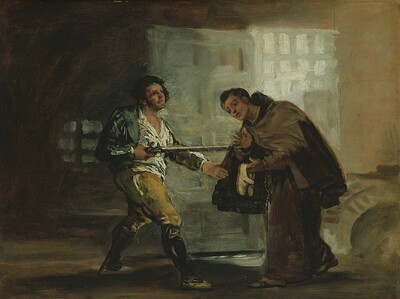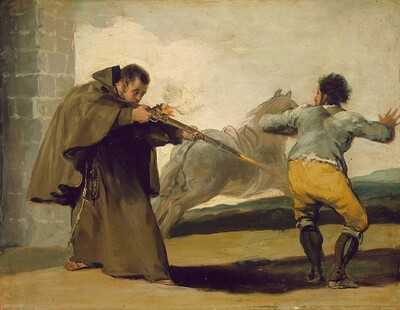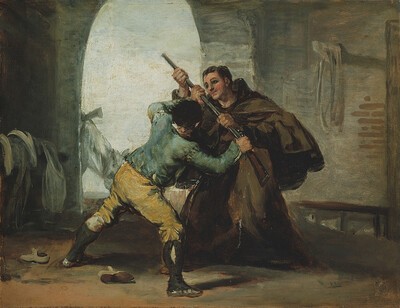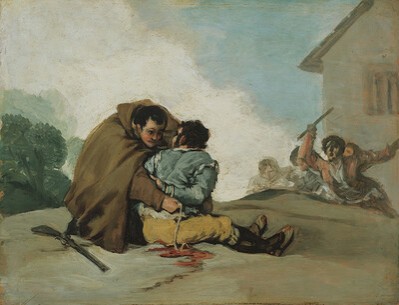- Cronología
- 1806 - 1807
- Ubicación
- The Art Institute of Chicago, Chicago, United States
- Dimensiones
- 29.2 x 38.5 cm
- Técnica y soporte
- Oil on wood panel
- Reconocimiento de la autoría de Goya
- Documented work
- Titular
- The Art Institute of Chicago
- Ficha: realización/revisión
- 02 Mar 2010 / 14 Jun 2023
- Inventario
- (1990. 558)
For a complete history of the bandit and an artistic analysis of the whole series El Maragato Threatens Friar Pedro de Zaldivia with his Gun.
The fourth episode in the cycle depicts the start of El Maragato's defeat. When the bandit tries to fetch the rifles from the horse, Friar Pedro turns the gun around and prepares to hit his enemy with the butt. The bandit has fallen to the floor, and looks up with fear at Friar Pedro, whose face reflects the doubt and inner conflict of one who is not entirely convinced of his actions. In the end, the monk on reflection decides not to hit the villain but the horse, which bolts in fright.
It has been pointed out that the friar's pose is inspired by classical depictions of Hercules beating wild animals. This is the moment which best describes the combination of Friar Pedro's humility on his arrival to the house taken over by the bandit, and God's fury which he carries inside, and which serves to help him capture the criminal, according to the leaflet. The fear in the face of El Maragato is inspired by the physiognomy of the Italian affetti which Spanish students learned in Rome. One of these was Velázquez, whose blacksmith in the painting Forge of the Vulcan (Prado Museum, Madrid) may have inspired Goya's portrayal of the frightened villain.
-
Spanish Paintings from El Greco to GoyaThe Metropolitan Museum of ArtNew York1928consultant editor Bryson Borroughs. From February 17th to April 1st 1928cat. 10
-
The art of Goya. Paintings, drawings and printsThe Art Institute of ChicagoChicago1941from January 30th to March 2nd 1941cat. 74
-
Goya. El Capricho y la Invención. Cuadros de gabinete, bocetos y miniaturasMuseo Nacional del PradoMadrid1993from November 18th 1993 to February 15th 1994. Exhibited also at the Royal Academy of Arts, London, March 18th to June 12th 1994 and The Art Institute of Chicago, Chicago, July 16th to October 16th 1994, consultant editors Manuela B. Mena Marqués and Juliet Wilson-Bareaucat. 87
-
Goya: Prophet der ModerneAlte NationalgalerieBerlin2005from July 13th to October 3th 2005. Exhibitied also at the Kunsthistorischemuseum, Vienna, October 18th 2005 to January 8th 2006, consultant editor Manuela B. Mena Marquéscat. 89
-
Goya en tiempos de guerraMuseo Nacional del PradoMadrid2008consultant editor Manuela B. Mena Marqués, from April 14th to July 13th 2008cat. 47
-
Noticia exacta de todo lo executado por Pedro Piñero, alias el Maragato, desde que se escapó de presidio, hasta que fue preso y herido por el Padre Fray Pedro de Valdivia, religioso lego de la Orden de San Pedro de Alcántara [Madrid, 1806]reimp. Imprenta de la calle de la Cintería1806
-
L'œuvre peint de Goya. 4 volsParís1928-1950vol. I, p. 247, cat. 218
-
Cómo vivía GoyaArchivo Español del Arte1946p. 86, 106
-
Goya’s source for the Maragato seriesGazette des Beaux-Arts1958pp. 298-304
-
Vie et ouvre de Francisco de GoyaParísOffice du livre1970pp. 157, 201, cat. 867
-
BarcelonaPolígrafa1970vol. I, p. 331, cat. 514
-
L’opera pittorica completa di GoyaMilanRizzoli1974p. 120, cat. 459
-
Francisco de Goya, 4 vols.ZaragozaCaja de Ahorros de Zaragoza, Aragón y Rioja1980-1982vol. III, p. 155 y p. 205 (il.)
-
Goya. El capricho y la invención. Cuadros de gabinete, bocetos y miniaturasMadridMuseo del Prado1993pp. 292-293, 376, cat. 87 y p. 297 (il.)
-
Goya en tiempos de guerraMadridMuseo Nacional del Prado2008pp. 218-219, cat. 47 y p. 219 (il.)





